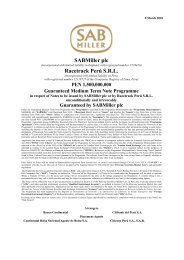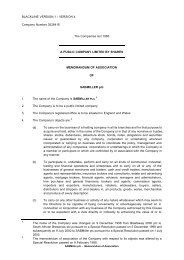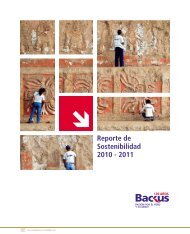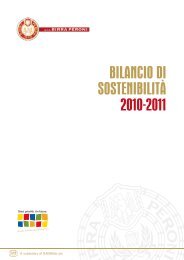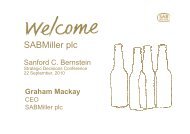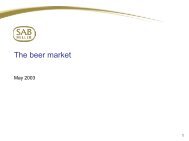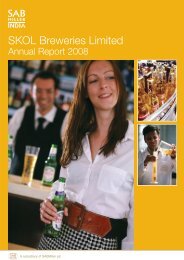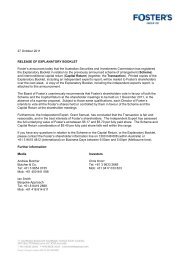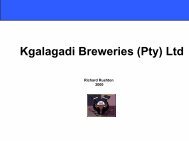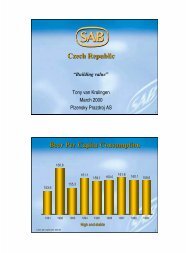March 2011 Annual Report and Financial Statements - SABMiller
March 2011 Annual Report and Financial Statements - SABMiller
March 2011 Annual Report and Financial Statements - SABMiller
You also want an ePaper? Increase the reach of your titles
YUMPU automatically turns print PDFs into web optimized ePapers that Google loves.
FINANCIAL STATEMENTS<br />
4. <strong>Financial</strong> risk management objectives <strong>and</strong> policies (cont)<br />
Market risk<br />
(i)<br />
Foreign exchange risk<br />
The company imports certain raw materials <strong>and</strong> services <strong>and</strong> is exposed to foreign exchange risk arising from<br />
various currency exposures, primarily with respect to the US Dollar <strong>and</strong> the South African R<strong>and</strong>. Foreign exchange<br />
risk arises from bank balances <strong>and</strong> recognised assets <strong>and</strong> liabilities.<br />
Currency exposure arising from liabilities denominated in foreign currencies is managed primarily through the<br />
holding of bank balances in the relevant foreign currencies.<br />
At 31 <strong>March</strong> <strong>2011</strong>, if the Kwacha had weakened/strengthened by 10% against the US dollar with all other<br />
variables held constant, post tax profit for the year would have been K20 million (2010: K188 million) higher/<br />
lower, mainly as a result of US Dollar denominated trade payables <strong>and</strong> bank balances.<br />
At 31 <strong>March</strong> <strong>2011</strong>, if the Kwacha had weakened/strengthened by 10% movement against the South African R<strong>and</strong><br />
with all other variables held constant, post tax profit for the year would have been K54 million (2010: K35 million)<br />
lower/higher, mainly as a result of South African R<strong>and</strong> denominated trade payables <strong>and</strong> bank balances.<br />
(ii)<br />
Price risk<br />
The company does not hold any financial instruments subject to price risk.<br />
(iii)<br />
Cash flow <strong>and</strong> fair value interest rate risk<br />
The company’s only interest bearing financial liability is the bank overdraft, which is at variable rate, <strong>and</strong> on<br />
which it is therefore exposed to cash flow interest rate risk. The company regularly monitors financing options<br />
available to ensure optimum interest rates are obtained. At 31 <strong>March</strong> <strong>2011</strong>, an increase/decrease of 2% would<br />
have resulted in a decrease/increase in post tax profit of K 15 million (2010: K117 million).<br />
Credit risk<br />
Credit risk arises from cash equivalents <strong>and</strong> deposits with banks, as well as trade <strong>and</strong> other receivables. The<br />
company does not have significant concentrations of credit risk as most of its trade is on cash basis.<br />
The amount that best represents the company’s maximum exposure to credit risk at 31 <strong>March</strong> <strong>2011</strong> is made up<br />
as follows:<br />
<strong>2011</strong> 2010<br />
Cash at bank <strong>and</strong> short term bank deposits 4,624 6,915<br />
Trade receivables 430 500<br />
Receivables from related companies 3,229 -<br />
Other receivables 2,197 107<br />
10,480 7,522<br />
26<br />
National Breweries PLC <strong>Annual</strong> <strong>Report</strong> <strong>2011</strong>



